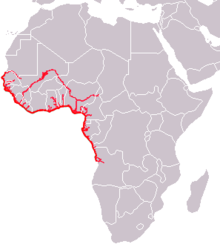African manatee
| African manatee | ||||||||||||
|---|---|---|---|---|---|---|---|---|---|---|---|---|

African manatee ( Trichechus senegalensis ) |
||||||||||||
| Systematics | ||||||||||||
|
||||||||||||
| Scientific name | ||||||||||||
| Trichechus senegalensis | ||||||||||||
| Link , 1795 |
The African manatee ( Trichechus senegalensis ) is a species of manatee from the family of manatees (Trichechidae).
It lives as the only representative of its genus in coastal and inland waters of Africa and is the least explored species in their family.
description
African manatees have the usual build of manatees: the trunk is round and stocky, the forelegs are converted into fins, the fluke (tail fin) is round, and the hind limbs are missing. The small head is characterized by the angular, massive snout, which is provided with numerous whiskers. The upper lip is split, each half can be moved independently of the other. The eyes are small, as are the ear openings, there is no external auricle. Outwardly, African manatees are very similar to the Caribbean manatees and only differ in the details of their skulls.
The thick skin is gray-brown in color and has colorless, bristle-like hair. Adult animals reach a length of three to four meters, their weight is a maximum of 500 kilograms.
distribution and habitat
African manatees live mainly in estuaries of rivers, in mangrove areas and swamps as well as in rivers; they penetrate far inland, along the Niger they even live in Mali , 2000 kilometers from the coast. Along the African Atlantic coast to their range extends from Senegal to Angola . The rivers in which these animals occur include the Senegal , Gambia , Volta , Niger , Benue , the lower reaches of the Congo and the tributaries of Lake Chad . However, their range is limited to waters with a temperature of over 18 ° C. The extent to which they inhabit seas is controversial, and reports have shown that they avoid saline waters.
Way of life
Not much is known about the way of life of the African manatee, presumably it largely corresponds to that of the Caribbean manatee . Like all manatees, these animals are permanently in the water and can no longer come on land. They either live solitary or in small groups of four to six animals, and their social behavior is poor.
African manatees are herbivores that feed on plants growing or hanging in the water. Due to the low nutritional value of these plants, they have to eat a lot, estimates amount to more than 20 kilograms per day.
Little is known about reproduction; the animals probably reproduce all year round. After a gestation period of around 12 to 13 months, the female is likely to give birth to a single young. This comes into the world with its tail first and can swim within a short time.
threat
Unlike the other species, African manatees have never been chased by organized hunting trips. Nevertheless, the IUCN classifies this species as endangered. They are hunted locally for their meat and fur. In some African countries, fishermen kill manatees because they accuse the animals of stealing fish from their nets. There have been isolated reports, at least from other manatee species, that this behavior could actually occur.
The African manatee is said to be relatively common in Gabon , Cameroon , Ghana and the Ivory Coast . In contrast, it has almost been wiped out in Senegal , Gambia , Liberia and Sierra Leone, for example .
literature
- Ronald M. Nowak: Walker's Mammals of the World . Johns Hopkins University Press, 1999 ISBN 0-8018-5789-9
- Sandra L. Husar: Trichechus senegalensis . In: Mammalian Species . No. 89, pp. 1-3 (1978).
Web links
- Trichechus senegalensis in the endangered Red List species the IUCN 2006. Posted by: Powell & Kouadio, 2006. Retrieved on 11 May, 2006.
